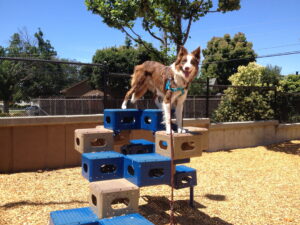
Whether you attach a leash to your dog’s collar or to a harness is pretty much a personal decision, but you should be aware that using a collar with a dog who has not learned to walk on a slack leash (at a human’s pace) could be at risk to some damage from the pressure of a collar on their throat. Possible damages can include:
- Neck injury – possibly resulting in pain and spinal problems
- Thyroid damage – the thyroid glands are found in the dog’s neck, and low thyroxine can lead to a number of health and behavior problems.
- Ear and eye damage – from pinched nerves or restricted blood flow
- Leg nerve damage – which might result in your dog licking their front paws in an attempt to relieve the pain. If you see this, consider whether it’s allergies (which would affect all four paws) or if it’s the collar.
My personal preference is to have the dog wear a collar with an ID tag at all times, and I highly recommend that all dogs wear a harness while walking – especially for dogs who over-react to triggers (other dogs, other people, cars, squirrels, etc). This keeps any pulling pressure off the dog’s neck, spine, throat and trachea during the walk.
A traditional harness, where the leash attaches to the back or behind the shoulders, might actually encourage pulling in some dogs (they make special harnesses for sled and carting dogs to encourage comfortable pulling). The newer front-clip harnesses reduce pulling in a lot of dogs and can help you keep control over your dog if she suddenly lunges after another dog, person or squirrel – these are harnesses like the Freedom, Balance, Front Range, Vari-Fit and Perfect Fit harnesses. Look for a harness designed to reduce pulling, with a clip in the front and a fit that does not impinge on the dog’s shoulders and elbows (if there’s a horizontal band that goes across the dog’s chest, it should be above the point where the legs attach to the chest.
I feel that finding the right harness for each dog is like finding the right shoes (or bra!) for each person – you might need to try a few out before you decide it’s the best fit. Here are a few harnesses designed to reduce pulling that I recommend (note that I have NOT been clever enough to make these affiliate links; I get nothing from recommending these except the assurance that your dog will be safer and more comfortable, and your walks will be easier!):
- Balance
- Front Range
- Perfect Fit
- Freedom (also at Gussied Up on Lincoln Avenue in Willow Glen – tell them I sent you!)
- Vari-Fit
- Connected Control (waterproof and vegan but pretty expensive!)
See an overview at whole-dog-journal.com.
Note that I do not really recommend the Easy Walk harness by Premier, which unfortunately is the one sold in almost every “big-box” pet store. I find that the front piece often hangs too low, and the whole harness tends to loosen up over time, so you have to constantly check to see if it needs tightening.
Other throat-protecting, pull-reducing options include head halters such as:
- Halti Opti-Fit
- Walk ‘n Train (no relation to my business!)
- NewTrix – leash attaches near back of neck
- Comfort Trainer
- Perfect Pace – leash attaches at back of neck
- Gentle Leader
And chest-strap harnesses such as
For a nice chart overview of these options, see petexpertise.com. PetExpertise will also create a custom harness with an optional front-clip “no-pull” ring; since these harnesses don’t seem to be especially designed to be “no-pull” I don’t know how well they’d work for that but it would be a well-fitting harness!
For more information on this, see
Note that all of these pieces of equipment are Quick Fix/Short Term solutions to pulling – they will not teach your dog how to walk on a loose leash. But they might give you the opportunity to catch moments of loose-leash walking, which you can then reward. Teaching a dog to walk in a straight line at a human’s pace on the most boring parts of the world (the sidewalk) is one of the most challenging things we ask our pet dogs to do. I’m happy to help you with that!
All material copyright Stacy Braslau-Schneck. Reprints for non-commercial use, and with the author’s permission only. Would you, your training company, or your club like to reprint this? Please be sure to keep my name, business name, and the website URL with the article, and if possible, please send me a copy. See the Contact page for email and mailing address.

